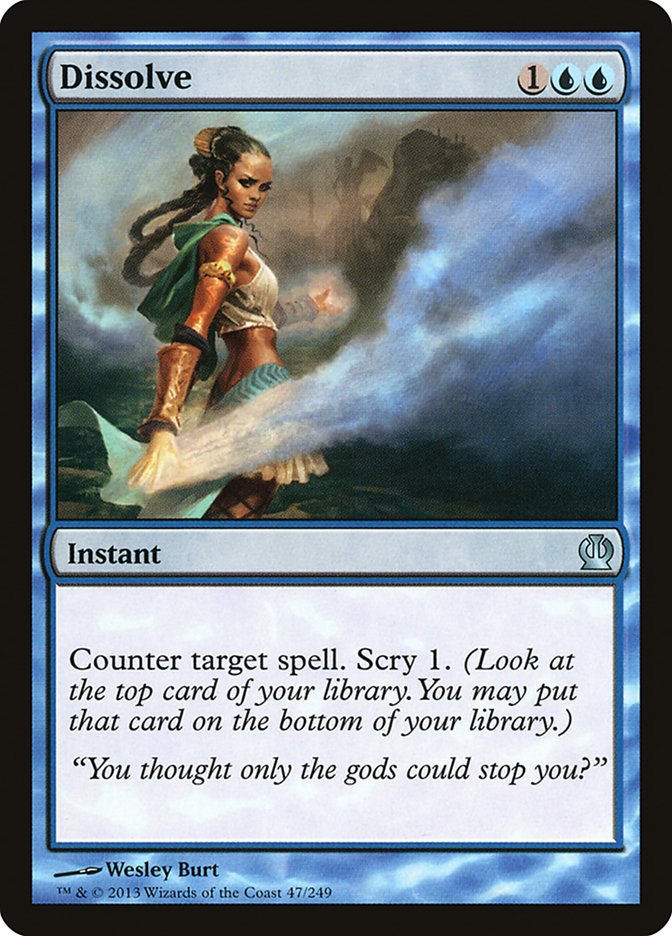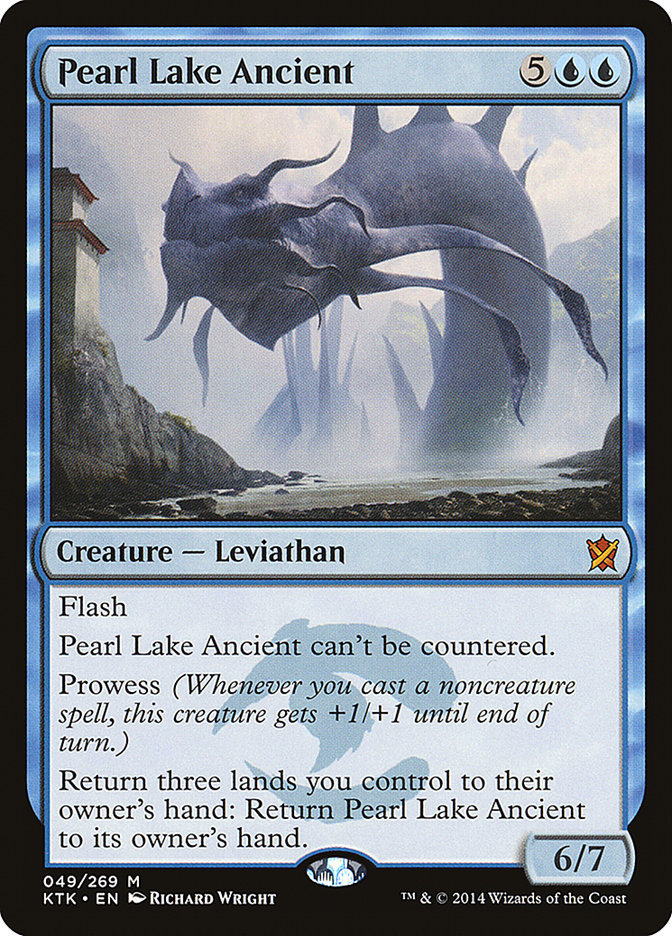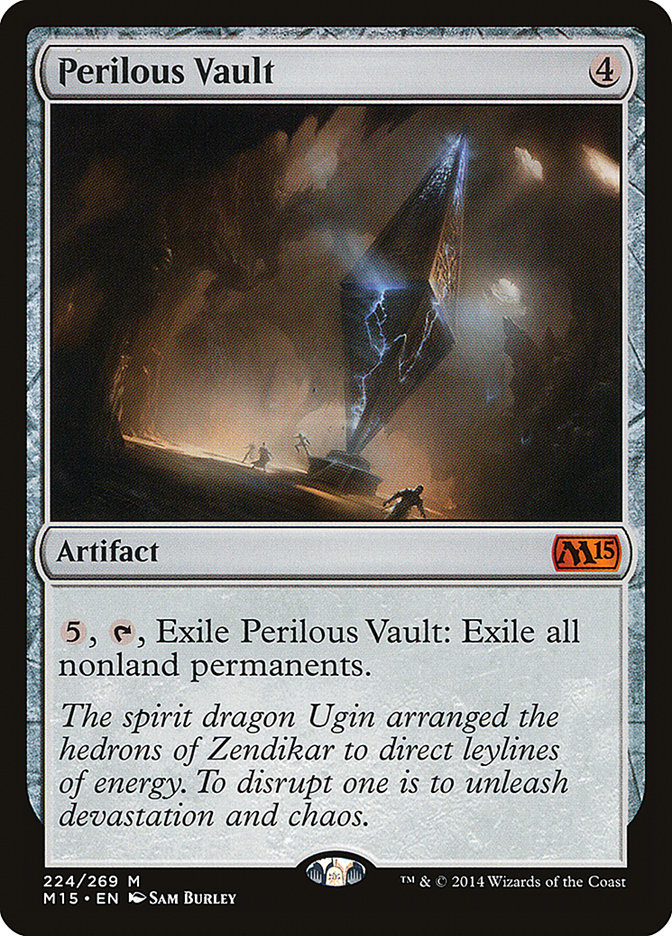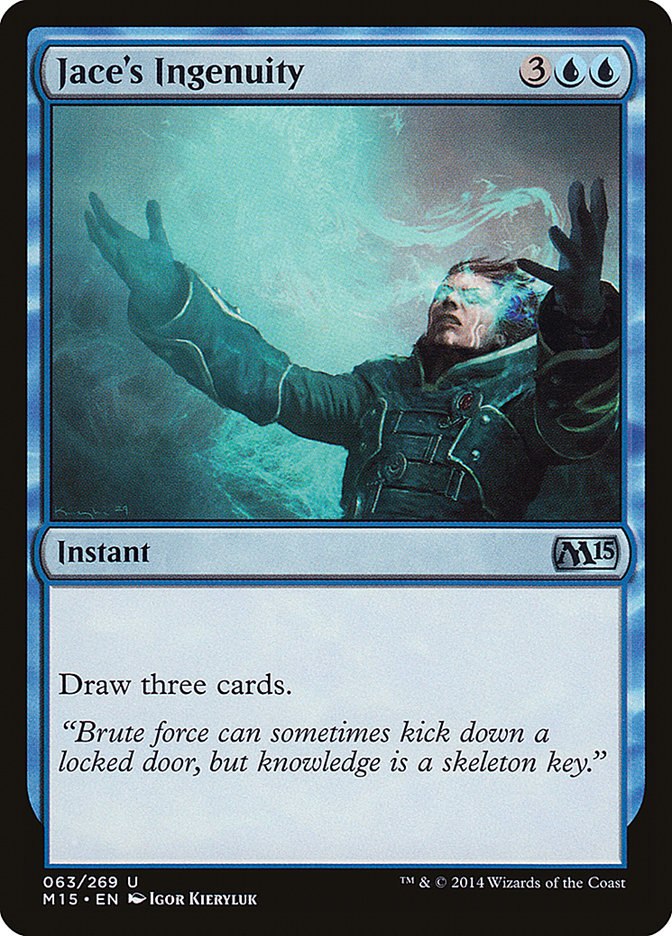I’ve been playing competitive Magic for quite a while and I’ve seen a fair share of exceptionally broken cards in my time.
You have cards that are absolutely broken in the context of a specific format but just don’t seem to hit elsewhere.
You have cards that are absolutely broken, but still resemble fair, “normal” Magic. When your opponent Snapcaster Mages a Swords to Plowshares,
Thoughtseizes a threat, draws Force of Will, Ponder, Scalding Tarn off Treasure Cruise, or taps Deathrite Shaman to cast turn two Liliana of the Veil, it
still feels like they were playing the same game as you were. Their cards were just way better for no reason and they just out-interact you as a result.
Then you have the real gems that don’t come close. The Skullclamps. The Mind’s Desires. The Stoneforge Mystics. You play them and…that’s just it. The
game ceases to resemble a normal game of Magic. You start breaking a ton of rules, and your opponent really has no way to match without playing the same
level of card.
It’s been a number of years since a card has been printed that fits that last category.
And now we have Dig Through Time. Have you read this card?
Let’s start off at the top, with Delve.
Delve might be the most degenerate mechanic in a long time. It’s Affinity for Dredge, plain and simple. How could anything this absurd make it out of the
doors?
Well, the first three Delve cards from Future Sight cards didn’t seem too crazy, but if you look at them it’s obvious as to why. Death Rattle is B, Destroy
target creature that isn’t Tarmogoyf, except you already have that effect for R and it also can deal 3 damage to a player in older formats (Lightning Bolt)
and for Standard purposes it was literally in the same set as the thing it needed to kill but couldn’t. Logic Knot is UU, conditionally counter a spell,
except UU already counters a spell in older formats. Guess what? It still saw play in formats without actual Counterspell, even being part of Shaun
Mcclaren’s Pro Tour Born of the Gods-winning deck earlier this year.
Tombstalker, the only not obviously obsolete card of the lot, saw a solid amount of play for a French vanilla creature.
And as a result, someone decided that the things we have now are OK.
As for the rest of the text on Dig Through Time?
Choose two of seven is the better part of a draw seven. Think about the average opener: two or three mana, two or three filler, and twoish gas. Pick the
gas or mana as needed, pass on the rest.
Instant card draw is virtually free by virtue of casting it end step and then immediately untapping, allowing you to always play reactively and optimize
how your cards line up against theirs.
Dig doesn’t even draw cards, so it avoids Notion Thief, Chains of Mephistopheles, and Spirit of the Labyrinth.
OK, that last one might be a stretch, but the rest are pretty absurd.
Let’s compare Dig through Time to its two closest relatives: Fact or Fiction and Gifts Ungiven.
Yes, two cards that have been restricted in Vintage. That’s the kind of company this card keeps.
Fact or Fiction gives you a choice between usually the best and the fourth or so best card of your top five and the second, third, and fifth best cards.
Dig gives you the first and second best of your top seven. If you hit five cards of similar power, maybe Fact or Fiction will be better, but odds are just
taking the two best is more than enough.
Gifts Ungiven is a bit trickier. Gifts typically gets you the best two cards in your deck at the cost of a few more mana. However, with the right amount of
redundancy, “choose two of your top seven” is pretty close to choosing two cards from your deck.
Wait – so Dig wants you to play redundant cards with different power levels? Does that make sense? In theory it doesn’t, but in practice you find it comes
up a lot. In Scapeshift, finding any land is fine, but Sakura-Tribe Elder is ramp that also gains life. In Legacy, choosing between the cheaper Show and
Tell and the less interactive Sneak Attack matters. And in Vintage, you just have the Restricted list which lets you play a bunch of draw sevens or Tutors
as long as they do different things.
Basically, my point is that a good percentage of the time, without even trying, Dig Through Time will be on par or better than Gifts Ungiven or Fact or
Fiction.
That’s Fact or Fiction of “End of Turn Fact or Fiction, You Lose.” Gifts Ungiven as in the card that was more dominant in Kamigawa Block than Umezawa’s
Jitte.
This is where this card is coming from.
Why Dig and not Cruise?
Treasure Cruise is the Delve draw spell that has been drawing the heat lately, and the numbers it has been putting up show it is for good reason. When
comparing the two cards, there are definitely hoops you have to jump through for Dig that you don’t for Cruise, and it happens that those are well suited
for a few already powerful archetypes.
Dig Through Time does cost a bare minimum of two mana, while Cruise costs only one. Delver and Burn were both top decks in Modern and Legacy before Khans
of Tarkir, and both decks fuel Delve while really wanting the extra mana. If all you are drawing are one-drops, that’s a lot of extra spell action that one
mana represents. Note that these things create a bit of a feedback loop where you want to play a bunch of cheap spells that hit the graveyard to fuel
Treasure Cruise and ensure it costs one mana, and those are the same cards that make you want to play the one drop card draw spell over the two drop one.
Once you start building a Treasue Cruise deck, you are incentivized to really make it a Treasure Cruise deck.
Dig Through Time does give you one less card than Treasure Cruise. If all of your cards are the same and you are land-light, the average Treasure Cruise
has similar value to Dig Through Time and the high end for Cruise is three action cards, which Dig will never hit. Again, Delver and Burn.
Finally, Dig does cost double Blue. In Modern, this is more of an issue as often you are just splashing Cruise and the second blue mana is hard to get.
Even if you aren’t, the Ravnica shock lands mean getting double of a color tends to cost a significant amount of life compared to the first source.
Wait, those are all results of extreme restrictions.
So if my deck actually has lands to tap for mana, cards with variable use or power level, wants to draw cards that don’t just cost one mana, and/or can
make a second Blue mana, why am I playing Cruise over Dig?
I’m not sure why you are either. Sorry Deathblade, it really makes no sense. Rudy is right. You should have Digs.
Keep in mind that Dig Through Time often costs a virtual zero if you have other instants. As always with good instant-speed card draw, if you leave it and
an answer open you are sure you have maximized your mana usage.
Three Dig Through Time
As odd as it sounds with how much I’m hyping the card, I’m not sure Dig Through Time is inherently a four-of in most decks.
Dig Through Time is not a combo with Dig Through Time. The second Dig Through Time doesn’t help cast the first. If I cast one, odds are I’m a bit away from
casting the second. In fact, if I cast a Dig Through Time, I’m not expecting to need to cast another. My opponent should no longer be part of the game as
soon as I get to cast more spells.
A lot of my lists with Dig Through Time are going to start on three copies of the card as a result. I don’t want two, but I want the first as often as
possible. Textbook definition of a three-of.
I’m also willing to be wildly wrong here. It’s very possible that Dig Through Time is so good that it just doesn’t matter if you draw multiples because you
still get to play one.
Remember this for the next portion as well, but Treasure Cruise decks are definitely Treasure Cruise decks, while Dig Through Time decks are decks that are
good at casting Dig Through Time and just get better when they do.
Building For Dig
I’ve discussed how to build for Treasure Cruise in a roundabout fashion in discussing where it’s applicable over Dig, but how do you build to play with Dig
Through Time? You can’t just slap it into a deck and expect to maximize the card’s full potential.
To be honest, I’ve seen a lot of decks where people think Dig is bad. In most cases, it’s not that Dig is bad, it’s that they have not built their deck to
make the best card they could run actually work for them.
What can we do to make Dig Through Time work for us?
There are two options here. You can either use Dig as your endgame to rebuild after longer attrition battles, giving you the two perfect cards to go from
near parity to well ahead, or you can use it as a card you cast and find two cards that win the game.
I’m partial to the latter, but we can start with the first as it’s easier.
If you want Dig as your controllish KO card that finds two great cards to break parity, there really isn’t too much you have to do to make the card work on
the casting side. A fetchland or two would be nice, but there isn’t a need to go deep on single-color fetches. Looking at Owen Turtenwald’s U/B Control list from Pro Tour Khans of Tarkir, you can see he only
plays six fetchlands including the Evolving Wilds, and only one of those fetches (Bloodstained Mire) is being played solely to support Delve.
But Dig isn’t Sphinx’s Revelation or Cruel Ultimatum. You can’t just build a game state where you cast Dig and it buries your opponent…. unless you have
things to find that do that.
You can’t really build a control deck with the express goal of Digging your opponent out of the game without having the other 56 or so cards already there.
Dig can’t find a generic two cards. It needs to find two tools that lock the game up for you:
Dig Through Time is why an otherwise lackluster-looking control deck was able to perform well at a Pro Tour, as well as being my second choice for the same
event.
There is one restriction on the Dig-control deck: your cards should go to the graveyard. Artifacts and enchantments are fine; just use moderation. Perilous
Vault is fine, Banishing Light is fine, just don’t overload on that effect. This is part of why I really dislike the current Dig-Miracles nonsense in
Legacy. You are playing a bunch of cards that are clunky to draw on top of enchantments and artifacts. While there are games where cards will funnel into
your graveyard and make Dig easy to cast, it’s just as likely that the card will end up contributing to one of the already existing clunky hands that deck
is prone to because you aren’t making it castable.
Now, casting Dig to directly kill your opponent? That takes a bit more effort.
If you are casting Dig Through Time for lethal, you need to understand when you plan on doing it.
If you’re an aggressive combo deck, that means casting Dig as a pseudo-tutor the turn before you are killing. Or, in an absurd case, the turn you actually
do kill them.
Based on my experience with Storm and Cabal Ritual, reaching threshold on turn three is fairly easy with just cantrips, fetchlands, and fast mana, so
casting Dig through Time on turn three is very reasonable. Three fetchlands and two cantrips enable this without even trying. As per above, that means
killing your opponent on turn four or going wild on turn three.
The former is fairly conducive to the timing of Modern. If the rule of the format is that combo can’t kill before turn four, using your turn three to set
up with Dig is great. The issue is that a lot of the Modern combo decks people are used to playing have to use their mana earlier to set up for the turn
four kill. Tap three, cast Deceiver Exarch the turn before I Splinter Twin. Cast Sakura-Tribe Elder to ramp into Scapeshift. Even more don’t fit into the
game play pattern that supports Dig. I don’t think that Amulet combo plays enough fetches to cast the card, and Pod has to be too creature-based. Odds are
the right Dig shell in Modern is a combo deck people have forgotten about that now has new assembly powers that are unique to it.
As for Legacy, turn four is a bit late. Casting Dig and killing them on turn three is great, but I still haven’t figured that one out yet.
The next time to cast Dig is similar to the control option: after you have made some exchanges, Dig ends it. This implies Dig is either used after your
opponents have fought over your cards to continue trying to kill them, or after you have forced these exchanges to set up the kill properly.
Both of these are why the card shines in Vintage, where the lines between combo and control are extremely blurred. But in other formats? I haven’t quite
figured out the combo-control side in Legacy, but that is because the powerful combo decks in that format require a fairly large deck commitment. In
Modern, the obvious application is Scapeshift. The combo is compact, giving you actual slots to fill with interaction. Via this interaction, you buy
yourself time to cast Dig, find your two set up cards that complete the kill, and win. This is also basically how Jeskai Tempo operates in Standard. Do
some stuff, and if the game continues to the point where you need to Dig Through Time you cast the card, find lethal burn, and end it.
Just remember the points I made above: you need diverse redundancy to have relevant choices with Dig Through Time. Selecting between Jeskai Charm and
Lightning Strike depends on their life total and your available mana. Choosing between Cryptic Command and Remand depends on what you are fighting, as does
choosing Sakura-Tribe Elder if you need to block for a turn.
We’ve barely scratched the surface with this card. Treasure Cruise was first out of the gate, but Dig through Time?
That’s the one to be afraid of.






